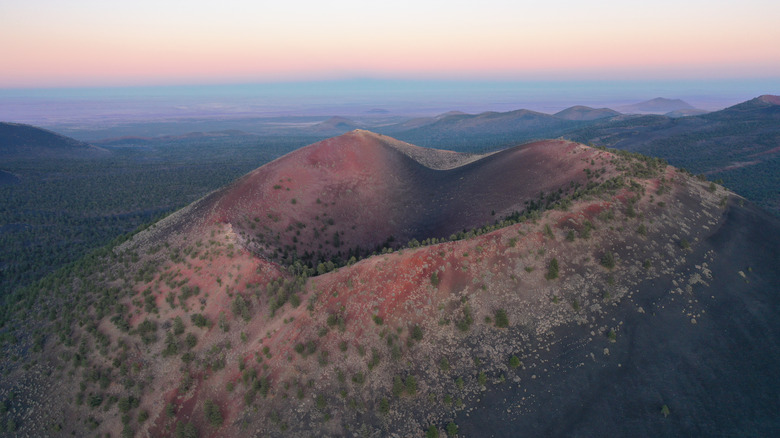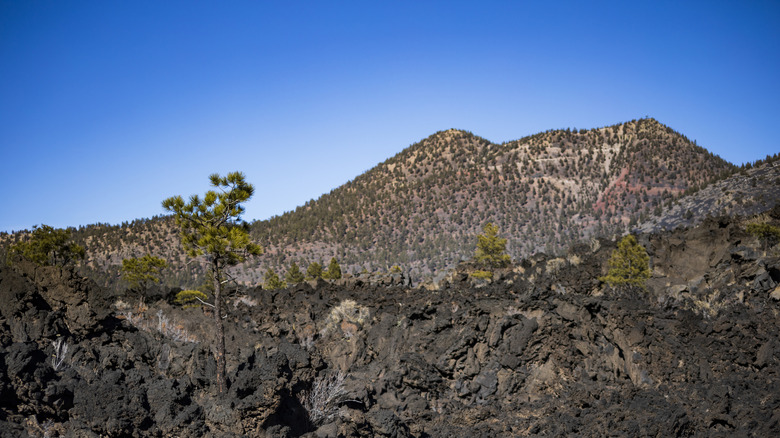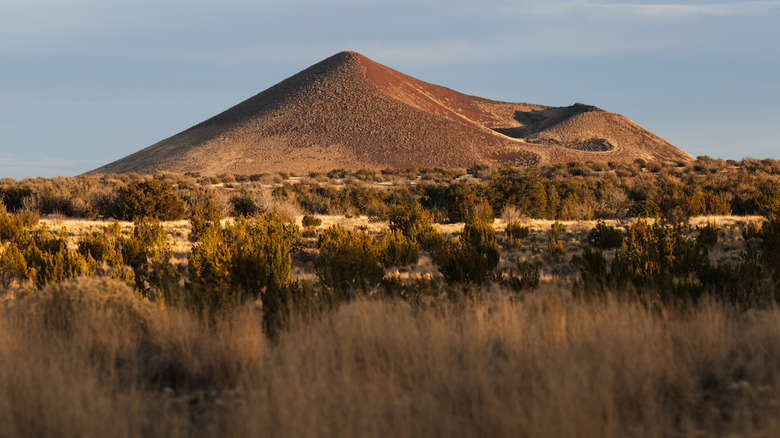Arizona's Last Volcanic Eruption Is A Quick Day Trip From Flagstaff With Awe-Inspiring Landscapes
From the ever-active Kilauea in Hawaii to the infamous Mount St. Helens in Washington, the United States has some of Earth's most notable (and notorious) volcanoes. And despite their obvious dangers, many of America's active volcanoes make for unforgettable visits! But most of America's volcanic destinations are located on the West Coast and the Hawaiian Islands, thanks to the hard work of the aptly named Pacific Ring of Fire. Arizona, for all its incredible geology, is generally thought to be too far east to have any volcanoes of its own. But, oddly enough, Arizona did have some notable volcanic eruptions of its own in the relatively recent geological past. The remnants of these unique eruptions can today be found in the amazing Sunset Crater Volcano National Monument.
Located just half an hour drive from Flagstaff, Sunset Crater Volcano National Monument boasts a striking landscape of volcanic artistry etched into the already-uncanny Arizona scenery. The Sunset Crater Volcano is the youngest volcano of the larger San Francisco Volcanic Field, which stretches across the Colorado Plateau in northern Arizona. In addition to Sunset Crater, the San Francisco Volcanic Field is also responsible for the nearby San Francisco Peaks (including Humphreys Peak, Arizona's highest mountain).
Not only does the park feature eye-catching examples of well-preserved volcanic cones, but the park's backdrop also includes epic scenery of Arizona's highest mountain peaks. All taken together, the Sunset Crater Volcano National Monument is a one-of-a-kind landscape with some of the best hiking (and photo) opportunities in the picturesque state of Arizona. And despite Flagstaff's enviable status as the "Gateway to the Grand Canyon," Sunset Crater is memorable enough to rival even the exalted canyon nearby as a top Flagstaff day trip.
Even in a state full of geological marvels, the Sunset Crater Volcano stands out
The Grand Canyon is consistently the most famous — and most crowded — tourist attraction near Flagstaff. Of course, the iconic canyon is large enough to offer hidden treasures, like the Grand Canyon's less-traveled backcountry Escalante route. But even with its world-famous views and secret backcountry hikes, the Grand Canyon does not hold a monopoly on amazing scenery or unique geology around Flagstaff.
In contrast to the Grand Canyon being carved by the Colorado River, the Sunset Crater Volcano's landscape was forged by fire. The result is a stunning contrast between lava-scarred terrain and pristine mountain peaks that hide the violence of their volcanic origins under a placid facade, ultimately creating one of Arizona's best-kept secrets for travelers.
Scientists estimate that the Sunset Crater Volcano formed around the year 1050 CE, in a violent eruption that impacted the region's native peoples. This particular eruption formed a type of volcano known as a "cinder cone." Cinder cones are a type of volcanic peak defined by a steep conical shape formed from volcanic ash and rocks emitted in a single, violent eruption. The Sunset Crater Volcano cinder cone is a particularly prominent example, reaching an altitude of around 1,000 feet, with an interior crater 300 feet deep. Plus, the surrounding landscape is a living geological museum of the lingering effects of volcanic eruptions. Walking around the park's main volcanic cone, you can see striking examples of preserved lava flows and jagged pinnacles of volcanic rock that testify to the park's violent past.
Sunset Crater Volcano National Monument is an underrated Arizona gem for scenic hikes and incredible landscapes
Sunset Crater Volcano National Monument offers the rare opportunity to see stark lava-burned terrain contrasted with lush forests of ponderosa pines and other beautiful trees. As a result, the park has some of the most unique landscape scenery you'll ever encounter. Even better, the park's top scenic views are all easily visible from the main hiking trails around the volcano. Many of the park's main trails are short and relatively easy hikes with up-close views of the remarkable lava fields. There's even a paved half-mile scenic route over the lava preserves!
The park also offers ranger-led hikes and interpretive programs to enhance your Sunset Crater experience even further. And if you're keen on stargazing, each summer the park hosts spectacular dark sky astronomy events with sublime views of the night sky. Though Sunset Crater Volcano National Monument has no camping areas, its visitor center is located right next to the excellent Bonito Campground in Coconino National Forest, generally open from May to October.
Of course, you can also stay overnight in nearby Flagstaff and take advantage of its many top lodging options for any budget. Flagstaff has long been lauded as one of the most charming small American towns, with a reputation for much more than just its proximity to the Grand Canyon. And since Flagstaff is surprisingly one of the snowiest mountain towns in America as well, it's also a prime four-season destination. Sunset Crater Volcano National Monument's convenient spot near Flagstaff, combined with its alien-like landscape that seems to be thousands of miles away from civilization (if it's even on Earth), makes the park a perfect stop on a memorable trip through northern Arizona.


